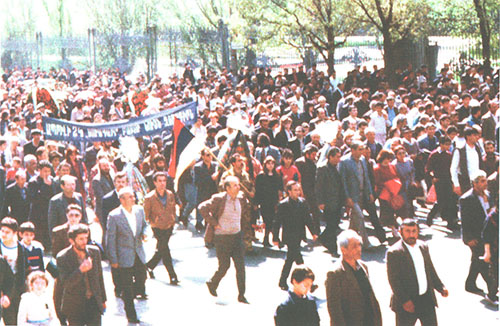
Out of the population of 1.7 million in Baku, the capital of Azerbaijan, more than 200,000 were Armenian. Typically, right from the beginning of the Karabagh Movement, the issue of the security of Armenians in Baku at that time and later was being linked to the developments of the Karabagh issue, not only by the Azerbaijani, but also the highest Soviet leadership. In a meeting of February 25, 1988, between Zori Balaian and Silva Kaputikian and Michael Gorbachev, the latter asked, “Have you thought about the fate of 207,000 Armenians living in Baku?”
The Armenian massacres in Baku in February 1905 and September 1918 were replicated in January 1990 with the result that no Armenian was left in Baku. The massacres in Baku were committed through the close collaboration of the Azerbaijani authorities and the National Front. Armenians were being battered, plundered, raped, killed with guns, knives and metal rods, thrown out of windows; people, dead and alive, were being burnt in fires. In a word, they put to work all the methods used during the massacres organized by Abdul Hamid, by the Young Turks during the Armenian Genocide, and later. This linkage was emphasized in one of the poster of April 24, 1990 rally that reads “April 24, Sumgait, Baku—It’s the Same Handwriting” (in Armenian). So, in people’s perception the toponym “Baku” became synonymous with genocide as was “Sumgait.” As evidenced even by the Azerbaijani eyewitnesses, here, just like in Sumgait, during mass slaughter, the militia and the bodies responsible to maintain law and order did not interfere at all.
Soviet troops entered the town only when the existence of Soviet rule was threatened. The number of Armenians killed in Baku during the massacres reached more than 400; however, the issue was never investigated. Once again killings, qualified by the people as “another genocide” were not condemned.
The fact of non-recognition of the Armenian Genocide by the whole international community, the active policy of denial by the Turkish authorities contribute to the continuation of genocidal acts, which we have witnessed also during September-November of 2020.
Dr. Harutyun Marutyan
Director, “Armenian Genocide Museum-Institute” Foundation
 Episode from the mourning march. April 24, 1990
Episode from the mourning march. April 24, 1990





